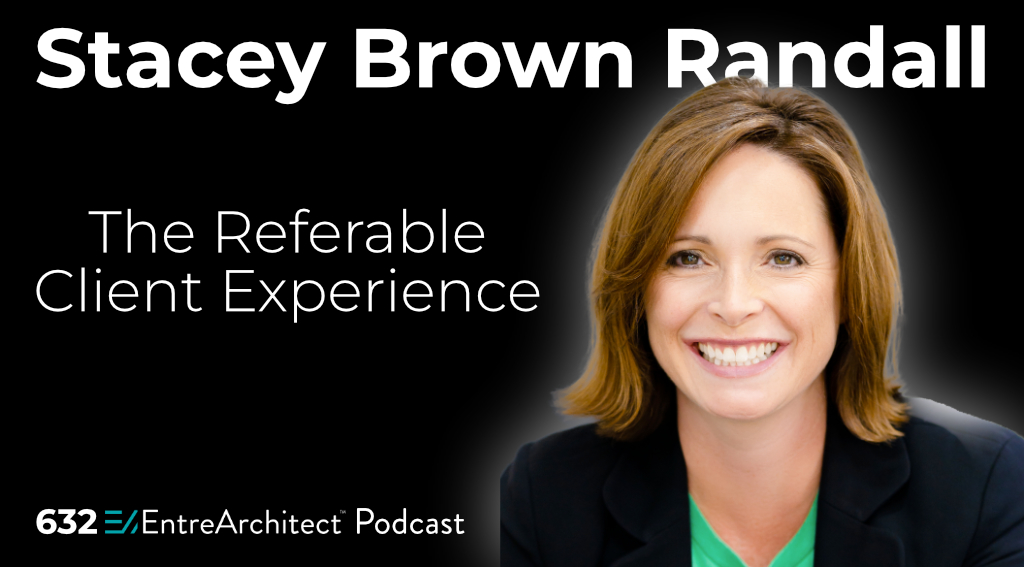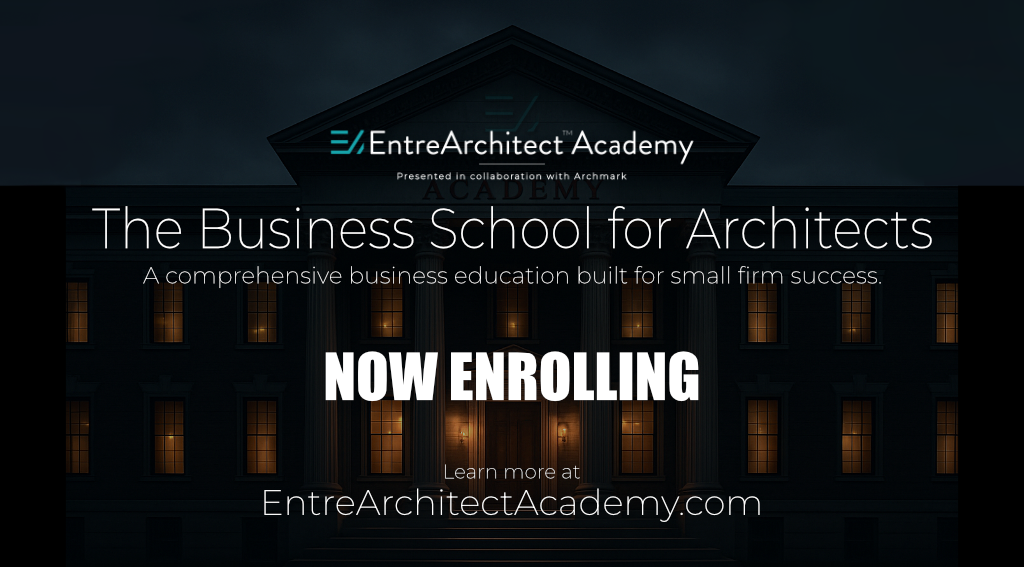
How to design feelings, moments, and language that quietly generate steady referrals.
The steady stream every small firm wants
If you have led a small architecture firm for any length of time, you know this truth. Referrals drive the best work. They arrive pre-aligned. Trust comes baked in. They shorten your sales cycle and increase your close rate. Yet many architects still treat referrals like lightning strikes, fabulous when they happen and mysterious when they do not. In my recent conversation with Stacey Brown Randall, we dug into her new book about building a referable client experience. Stacey has helped thousands of business owners generate referrals naturally without asking, paying, or playing gimmicky games. What I learned from Stacey will help you turn referrals from a happy accident into a reliable system.
Referrals are evergreen but your approach needs structure
Stacey reminded me that the fundamentals of referrals do not change. What has advanced is how we implement the fundamentals with clarity and repeatability. The goal is not a single trick. It is an ecosystem. Architects have long, complex, high trust projects. That is an advantage because you have time to build deep relationships. It is also a challenge because long timelines create lulls, waiting periods, and opportunities for doubt. A referable client experience recognizes both realities and designs how you will show up through the entire journey.
What a client experience really is
Most of us describe client experience as the sum of steps our clients go through. Stacey pushes us to define it as how clients feel while working with us and how those feelings endure after the work is done. Delivering great drawings and a beautiful building is not enough if the experience along the way is confusing, lonely, or stressful. Feelings drive stories. Stories drive referrals. That is why we must design to feelings, not only to tasks.
The three stages every architect should design
Stacey breaks the journey into three stages. New. Active. Alumni. New is the short onboarding stage from the moment a client says yes until the real work begins. Active is the long middle where design, approvals, and construction live. Alumni is everything after the project ends. The work touch points belong mostly to New and Active. The relationship touch points belong to all three, and they are the engine of referability.
Speak to the quiet voice in the New stage
In New, your client is excited and nervous. Stacey calls this the quiet voice. They just committed serious money and entrusted you with something precious. This is the perfect moment to seed referability by meeting an emotional need. A simple handwritten note can do the job if it speaks to the quiet voice. Not “thanks for being our client.” Instead, tell them you understand the journey is long, sometimes confusing, and that they are not alone. You have done this before. You will guide them. You have them covered. Small, sincere gestures that acknowledge feelings set the foundation for what comes next.
Avoid the lull in the Active stage
Active is where architects excel at the work and sometimes struggle with the relationship. Timelines stretch. Permitting drags. Owners wait and wonder. Your team is busy. Weeks pass between visible milestones. This is where complacency sneaks in. A referable experience anticipates quiet stretches and designs small, human touch points that reduce uncertainty. Think about a cadence of simple updates that communicate even when there is nothing new. Short videos that explain the next phase. A calendar roadmap that clarifies what to expect and when. A note when you submit for zoning, a heads up before the first contractor walk, a check-in after the first round of bids. None of this is complex. All of it protects the feelings that fuel referrals.
Alumni is a relationship, not a finish line
The work may end. The relationship does not. Your alumni are an ongoing community of people who can extend the lifetime value of your firm through testimonials, repeat work, and referrals. Treat them as alumni. Share occasional firm updates that serve them. Invite them to a small open studio event. Send a simple project anniversary note with one idea for caring for their building this season. Alumni touch points do not need to be fancy. They need to be genuine, helpful, and aligned with how you want them to feel about working with you.
Find your referral hot zones
Across New, Active, and Alumni, certain moments tend to generate referrals. Stacey calls them hot zones. The first time a client sees a concept that resonates. The moment approvals land after a long wait. The day they move in. The first post-occupancy win. These hot zones are not about asking for referrals. They are about noticing where feelings peak and designing language and gestures that quietly plant seeds. The seed might be as simple as framing the win as something they will be proud to share. The seed might be offering help if people in their circle have questions about the process. You are not asking. You are being helpful.
Language matters more than collateral
Architects love materials. Leave-behinds. Brochures. Links and decks. Stacey’s counsel surprised even me. Do not push collateral into a referral moment. It shifts the energy from relationship to sales and makes your client feel like they have homework. If they ask for something to share, provide a simple link or one clear page. Otherwise trust the relationship you have built. People refer people they trust, not brochures they received.
The single best sentence when a client wants to refer
When a client says, I want to tell my friends about you, the natural temptation is to ask for names. Resist it. Shift from asking to helping. Try this. “As you show your friends what we have done together, they will probably have questions about the process. If it is easier, connect me, and I will happily answer their questions so you do not have to.” You just made your client the hero. You reduced their fear of doing it wrong. You opened the door to a warm connection where trust can be transferred. That is how referrals are born.
Not all referrals are the same
Stacey teaches three streams. The right people. Hot zones. Referral moments. Sometimes you simply meet a client who naturally refers. You cannot script that. You can recognize and nurture it. Hot zones are the moments in the journey where feelings are high. Referral moments are the words your client says that open a door. In each stream, your job is to use the right language, at the right time, in the right tone. That is craftsmanship. Practice it like any other skill your firm values.
Centers of influence are a different strategy
Referrals from clients are one lane. Referrals from centers of influence are another. Contractors, real estate professionals, interior designers, and others who meet clients before you do are powerful partners. Do not treat them like clients. Design a separate plan to cultivate them. Identify who already swims upstream of your best work. Build a relationship that helps them win with their clients. Understand the kind of projects they see and the problems they need solved. When they think architect, you want them to think of you. This is not a mass email. It is relationship work done on purpose.
Track five data points or you are guessing
Architects love data when it comes to buildings. Bring the same discipline to your pipeline. Track every inquiry with five simple fields:
- Date.
- Name.
- Source.
- Outcome.
- Revenue.
If the source is a referral, record the person who referred them by name. That one field will change how you see your business. You will know which referral sources send right-fit work and which do not. You will spot closing issues. You will calculate the real ROI of your efforts and stop doing what does not work. If your CRM cannot capture the referrer’s name for referred leads, add a custom field today. You can run this in a spreadsheet if you need to. The point is to see the truth.
Extend lifetime value by design
When you view a client only as the fee from a single project, you miss the compounding effect of relationships. Lifetime value includes the project you deliver, the testimonial that helps you win the next one, and the clients they refer over years. If you design for feelings and follow through with simple systems, you turn each client into a tiny engine that fuels the next project. That is how a small firm builds momentum without burning out on cold outreach.
The first practical step you can take today
Grab a pencil and a sheet of paper. Map your current client experience from the exact moment someone says yes. What happens next. Then what happens. Keep going until the ribbon cutting and beyond. Separate work touch points from relationship touch points. Note the time between them. Circle the places where a client might wait and worry. Put a star where feelings tend to peak. Now choose one small relationship touch point to add to the New stage that speaks to the quiet voice. Choose one small touch point in Active that reduces uncertainty during a lull. Choose one simple Alumni touch point that keeps the relationship warm. Do not attempt to overhaul everything. Build your ecosystem one intentional moment at a time.
Why this works for architects
Our profession already designs experiences. We just do it for buildings and users. Apply the same mindset to the business side. You are designing how clients feel about working with you. You are designing the stories they will tell about you when you are not in the room. You are designing the path for trust to move from one person to another. When you do this with care, referrals become the natural byproduct of a practice built on service, clarity, and respect.
Listen to the full conversation
We covered much more in the episode, including how to identify your referral hot zones, the exact phrasing to seed referrals without asking, and the metrics that reveal where your best opportunities live. If you want more of the right clients coming in the right way, do not miss it. Listen to the full episode at https://entrearchitect.com/632.
Key takeaways you can implement this week
Design for feelings, not just tasks. Feelings drive stories. Stories drive referrals. Map your experience in three stages. New, Active, Alumni, with both work and relationship touch points. Speak to the quiet voice in New. A simple handwritten note that promises guidance beats a generic thank you. Protect emotions during lulls in Active. Communicate even when nothing appears to be happening. Treat Alumni like a community. Keep relationships warm with useful, occasional touches. Use helpful language in referral moments. Offer to answer friends’ questions rather than asking for names. Track five data points for every lead. Date, name, source, outcome, revenue, with the actual referrer’s name captured. Build a distinct COI plan. Clients and centers of influence require different strategies.
Your next right move
Block 45 minutes on your calendar. Map your current experience, mark the lulls, and write the one welcome note you will send to every new client from now on. Then open your CRM or spreadsheet and add the referrer name field. Small, intentional moves compound. That is how you build a referable client experience and a pipeline you can trust.

Leave a Reply